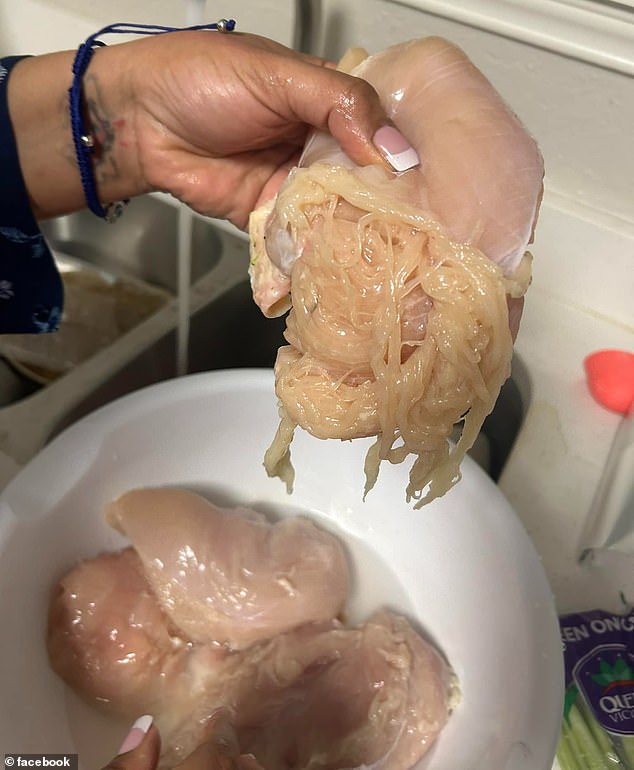- ‘Spaghetti meat’ is the result of fast-growing chickens raised in the meat industry
- Your muscles can’t keep up with the growth and that’s why the fibers separate.
- READ MORE: Goat in Minnesota tests positive for H5N1 bird flu strain
<!–
<!–
<!– <!–
<!–
<!–
<!–
Social media was left disgusted after learning what ‘spaghetti’ chicken is, after a mother’s post went viral on X.
Alesia Cooper, from Texas, was washing chicken breasts as part of her children’s dinner when the raw meat began to fall apart in her hands and became fibrous and soft.
Mrs Cooper, who had shopped at budget supermarket Aldi, wrote: “I think it’s fake meat.”
But X fact-checkers revealed that this was probably a case of “spaghetti meat”, a phenomenon that affects a small percentage of poultry.

Alesia Cooper, from Texas, posted a photo of a chicken she had bought at Aldi that looked like stringy spaghetti.


Mrs. Cooper was washing chicken breasts as part of her children’s dinner.
Spaghetti meat is said to be the result of breeding to make large breasted chickens grow faster.
When some chickens grow to an abnormally fat size in a short period of time, their muscle tissues often do not receive enough oxygen, which can cause the fibers to separate and become fibrous.
The meat is still safe to eat, although it may have a chewier texture than usual.
Chickens raised for meat, also known as broilers, are growing much faster than before, about twice as fast as they were 50 years ago, according to the National Chicken Council.
In 2000, the average bird arrived at market at 47 days old and weighed 5.03 pounds. In 2022, the average chicken still hits the market on the 47th day, but it now weighs 6.56 pounds.
And in 1925, it took chickens 112 days to reach a commercial weight of 2.5 pounds.
This is the result of genetic selection to breed birds that grow chest muscles more quickly, so there is more meat per bird and therefore more profits.
“Spaghetti meat” is what researchers have called chicken breast fillets that can be separated by hand to obtain what looks like stringy spaghetti.
They first appeared in 2015 and were detected in approximately four to five percent of breast meat samples in 2019, according to the report. Wall Street Journal reported.
“There is evidence that these anomalies are associated with fast-growing birds,” Dr. Massimiliano Petracci, professor of agriculture and food sciences at the University of Bologna, Italy, told the WSJ.
Meat scientists believe that the rapid growth rate of commercially raised chickens may cause breast muscle tissue to outgrow the oxygen supply offered by the chickens’ growing circulatory systems, which may cause muscle fibers to degrade and separate.
Companies like Wendy’s and Whole Foods are switching back to slower-growing chickens, as Whole Foods shoppers believe that slower-growing chickens with a better quality of life will taste better.
“I’ve been debating whether to post this, but since I had to see it you all did too,” Ms. Cooper said.
“I was cooking my kids dinner a couple of weeks ago and I was cleaning the meat like I normally do and when I started cooking again it turned into this…I haven’t made boneless chicken since.”
In addition to “spaghetti meat”, there is also “woody breast”, when the chicken is tough and chewy.
Experts have said that altered meat density and texture can occur for the same reasons as spaghetti meat.

